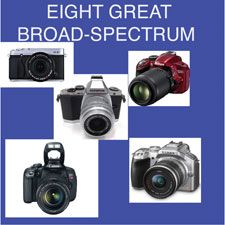
When it comes to taking photography to the next level, there’s still nothing quite like a digital SLR, and that’s why millions of consumers who started out as happy point-and-shooters are now moving up the camera food chain.
These days, DSLRs are facing stiff competition from next-gen compact interchangeable-lens, mirrorless cameras (ILCs) fielded by all the major players, but only a handful (e.g., the Sony NEX-7, NEX-6 and Olympus PEN E-P3 with optional EVFs) provide the full DSLR experience of having a high-magnification, high-res, eye-level viewfinder—still the most satisfying way to compose and view subjects in any light.
Also vying for their attention and dollars are dozens of attractively slim, ultrazoom cameras that provide all-in-one convenience. But none can match the optical flexibility and viewing advantages of a DSLR. Perhaps that’s the reason the DSLR category—especially models in the entry-level and step-up categories—are still the most popular choice of emerging enthusiasts and committed shooters who want cameras they can grow with.
In this technologically driven market, where camera designers are constantly coming up with ingenious new ways to provide the DSLR shooting experience, deciding which cameras fall into the entry-level or step-up categories is challenging to say the least. While cameras like the Sony Alpha SLT-A57, Olympus OM-D E-M5, Samsung NX20, Panasonic Lumix DMC-G5 and Fujifilm X-E1 are technically not DSLRs because their viewfinders are electronic (EVF) rather than optical, they all offer high-magnification eye-level viewing and provide a DSLR shooting experience for the person behind the camera. As the saying goes, if it quacks like a duck . . . etc.
Differentiating between entry-level and step-up models is a little trickier, because all the cameras on our short list are truly broad-spectrum models that are popular with both emerging and seasoned photo enthusiasts and even a few pros. What consumers can get for a little over a thousand bucks these days is truly remarkable in terms of performance and features, so perhaps a higher selling price is the only significant factor that sets step-up models apart.
After careful scrutinizing, cogitating and head scratching, here are eight outstanding DSLRs that will provide point-and-shooters (and anyone else) with impressive value and plenty of room for advancement. They will also provide ample opportunity for dealers to sell lenses, accessories and, eventually, mid and upper tier cameras as your customers grow their systems.
Nikon D3200. Nikon’s newest broad-spectrum model boasts one standout feature serious enthusiasts are salivating over—a 24.2MP DX-format, APS-C-size CMOS sensor that provides the highest resolution in its class. It also incorporates Nikon’s state-of-the-art Expeed 3 image processor claimed to provide faster AF, shorter shutter lag times, an expanded dynamic range, and a maximum 4-fps burst rate at full res. Other features include: a guide mode; a 921k-dot, 3.0-inch LCD with live view; four AF area modes (face-priority, wide-area, normal area, subject-tracking, full-time servo AF); an 11-point AF system; and ISO 100–6400 (plus ISO 12,800 in Hi 1). Full HD 1080p video and remote control operation have been upgraded with an external stereo microphone jack and a jack for the optional WU-1a—a wireless mobile adapter that lets users send images automatically to a smartphone and use the phone as a remote control for taking pictures or recording video. $699.95 with AF-S DX Zoom-Nikkor 18–55mm lens. nikonusa.com
Canon EOS Rebel T4i. This advanced entry-level compact has an 18MP APS-C CMOS sensor integrated with Canon’s latest state-of-the-art Digic 5 image processor to provide impressive specs. These include a 5-frames-per-sec burst rate, 9-point cross-type sensor AF system, a top ISO of 12,800 that’s expandable to ISO 25,800 and, for the first time in a Rebel, Full HD 1080p video recording at 30p, 24p and 25p with continuous autofocus. Its high-res (1.04 million dots), 3.0-inch touch-screen LCD tilts and swivels, and Canon’s new Hybrid CMOS AF system combines contrast-detection and on-sensor phase-detection AF for claimed faster, more accurate AF and focus tracking. Other features are: multi-shot noise reduction; a built-in stereo microphone; silent autofocus when using Canon’s STM lenses; scene intelligent auto mode; handheld night scene mode; HDR backlight control; and seven creative filters. $1,149 with EF-S 18–55mm IS STM lens. usa.canon.com
Samsung NX20. The latest, most advanced model in Samsung’s APS-C-format NX line of mirrorless DSLR-like cameras, the NX20 is the only one configured like a DSLR, complete with built-in eye-level viewfinder. Clearly aimed at serious enthusiasts seeking high imaging performance plus cutting-edge tech at an enticing price, as we noted in our October issue, the NX20 features a 20.3MP APS-C CMOS sensor, a 3.0-inch AMOLED swiveling monitor, Full HD 1080p stereo video capture, 2D/3D panorama capability and instant sharing via built-in Wi-Fi. Its maximum burst rate is an impressive 8 fps and it includes smart auto mode, filter effects and ISO settings as high as 12,800. Its i-Function 2.0 system makes it easy to adjust key settings through a button and the value ring on the lens, instead of the body. $999.99. samsung.com
Sony Alpha SLT-A57. Like all current Sony Alphas, the A57 uses a translucent stationary mirror design that enables full-time phase-detection AF. As a result, the 16.1MP, APS-C-format A57 can shoot full-resolution images at 10 fps and a blistering 12 fps at 8MP with 1.46x magnification in tele-zoom continuous advance priority AE mode. It also records Full HD 1080p video in AVCHD 2.0 progressive format at 60 fps or cinematic 24 fps—all with continuous AF. The A57 also includes: an upgraded Tru-Finder EVF; a fully articulated 921k-dot, 3.0-inch LCD that swings down 180º and swivels out 270º; a 15-zone AF system with three cross-field sensors and built-in sensor-shifting SteadyShot Inside image stabilization; sweep panorama mode; three-step auto HDR; and superior auto mode. In addition, it offers Clear Image enhanced digital zoom, auto portrait framing and multi-frame noise reduction. $699.99 with 18–55mm lens. sony.com
Panasonic Lumix DMC-G5. This recent addition to the Panasonic Lumix line of mirrorless Micro Four Thirds-format cameras has a tiltable, rotating 3.0-inch, 920k-dot touch-screen LCD plus a 1,440,000-dot eye-level live viewfinder, both of which show a 100% field of view. Its 16.05MP Live MOS sensor interfaces with a redesigned Venus engine image processor to provide such advanced features as Full HD 1080p video capture at 60 fps, contrast AF, touch AF and “light speed” AF, as well as a claimed ultra-low shutter lag time. Other cool features include: 14 adjustable in-camera filters; electronic silent shutter mode for discreet shooting; and beginner-friendly scene guides, creative control mode and intelligent auto mode. $799.99 with Lumix G Vario 14–42mm lens. panasonic.com
Olympus OM-D E-M5. The flagship of the Olympus Micro Four Thirds system sure looks like a classic DSLR and provides similar functionality in a small, light package. Its feature set includes: a 16.1MP Live MOS image sensor coupled to a TruPic VI processor; a built-in high-def eye-level EVF providing a 100% view and an astounding 120-fps refresh rate; a 3.0-inch, 610k-dot, tilting touch-screen OLED monitor; and an innovative five-axis sensor-shift image-stabilization (IS) system that delivers shake-free images when shooting stills or 1,920×1,080 Full HD video handheld. The camera is claimed to drive image data off the sensor at an incredible 240 fps to provide super-speed AF tracking, 3D tracking and an impressive 9-fps burst rate. Other features include: 11 art filters; ISO to 25,600; multiple exposure mode; a digital leveler; movie effects; and a dustproof, weatherproof magnesium alloy body that comes in black or silver. $1,099 with 14-42mm lens. olympusamerica.com
Fujifilm X-E1. Here’s a striking new concept—an enthusiast/pro camera that functions like a DSLR but looks and handles like a classic rangefinder 35, complete with analog dials! It delivers on its sleek, high-tech design, too, with a 16.3MP APS-C-format X-Trans CMOS sensor that has a unique color pixel array designed to reduce noise and increase resolution. Also notable is its ultra-high-res 2.36M-dot OLED eye-level viewfinder, 2.8-inch 460k-dot LCD, Full HD 1080p video capture with stereo sound and film simulation, motion panorama, 6-fps continuous shooting, a focal-plane shutter, ISO 25,600, dynamic range and film simulation bracketing, and a rugged, magnesium alloy body that comes in two color tones. The X-E1 uses a unique X mount (with a 10-pin data bus) that’s only 2.5mm thick, contributing to the camera’s slim profile. $1,399.95 with XF 18–55mm OIS lens. fujifilmusa.com
Pentax K-30. This handsome, ergonomically contoured classic DSLR delivers many of the features of the top-of-the-line Pentax K-5 IIs at an enticingly moderate price. These include: a 16.3MP APS-C-format CMOS image sensor; Prime M image processing optimized for Full HD 1080p video; an advanced SAFOX IXi+ AF system; 77-segment metering; continuous 6-fps bursts; a 3.0-inch wide-view, 921k-dot LCD; a 100% view optical pentaprism viewfinder; ISO expandable to 25,600; auto picture and scene modes; in-camera HDR; and a robust, weather-sealed body. The K-30 uses rechargeable Li-Ion or AA batteries. $849.95 with 18–55mm DA L lens. pentaximaging.com





